The Dolomites in the Italian Alps is one of the most popular areas in the Alps in general. So finding a last minute accommodation in the official huts may be hard.
But there are numerous free bivouacs and shelters where you can stay overnight, you have them all presented here.
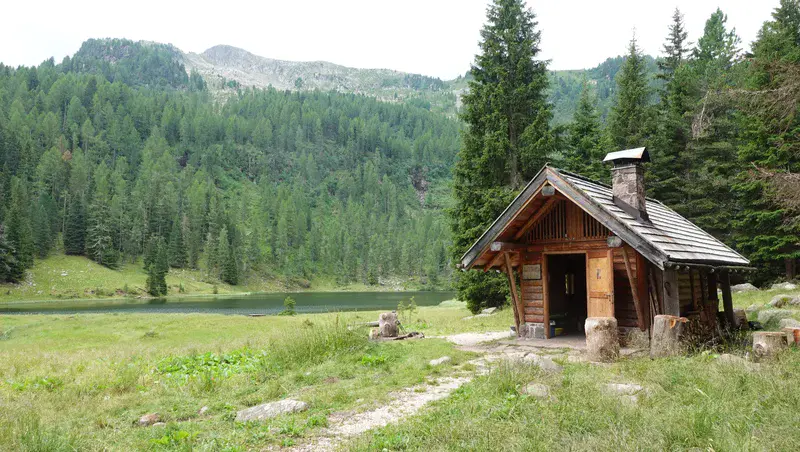
Why this text
There are many huts in the Dolomites, but as mentioned, most of them are booked months in advance. This is because of the general popularity of the area.
But one of the reasons is also that many of the huts are on the Alta Via routes in the Dolomites. There are 10 of them, just to know.
On the other hand, most of huts are open only during snow-free months, late June to early September period, and they are closed in the rest of the year. Very few of them may have a winter room where you can sleep.
So free shelters and bivouacs can be an alternative if you plan to walk any of the mentioned Alta Via routes. You can have meals in the huts, but sleep in the shelters. But the same holds if you are visiting the Dolomites area for general hiking, backpacking, and mountaineering.
In this post you have an integrated interactive and zoomable map which I painstakingly created, with all the free shelters of various types that I was able to find. They include the following types:
Alpine bivouacs
These are mostly (but not aways) high-altitude steel containers with a very basic equipment. In most of them you can expect simple beds or just wood platforms, blankets, and pillows. But it is advisable to always carry your own sleeping bag.
Some of them may have gas containers and stoves, but this is not guaranteed. So if you plan to cook anything, it is best to have your own stove with you.
These bivouacs are always open, and they are maintained by various regional or national alpine clubs.

Wood or stone cabins and shelters
In most cases these are shelters built and maintained by some local groups and volunteers. Typically, you will find them at lower elevations, within the tree line.
But there are exceptions of course, some are built or re-built at places of military cabins from the WWI, like the Bivacco della Pace in the picture:
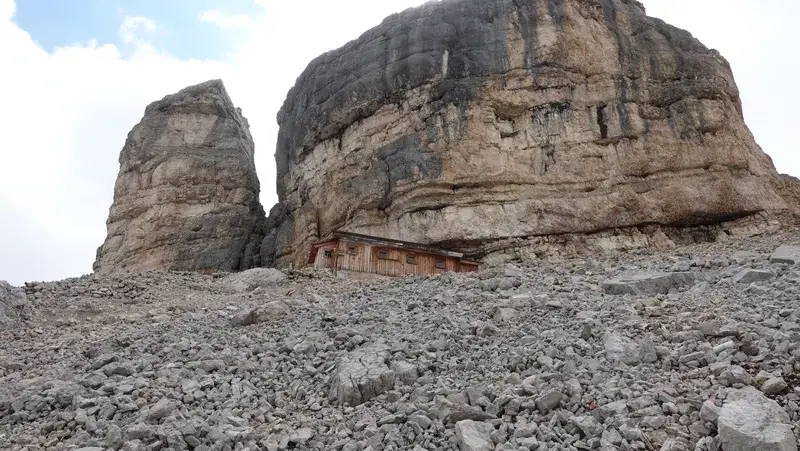
Many of those shelters at lower elevations are with a wood burning stove (stufa in Italian), and you will also have wood available in most of them.
Note however that wood may run out later in the season, so this is also not guaranteed. I have experienced that myself in a number of them.
In such cabins and shelters you will sometimes have a box on the wall with the inscription “offerte” (which means offers). The same holds for many other cabins of that type elsewhere in the Italian Alps.
So the word ‘free’ used in the title has a bit broader meaning. Offers (if the box is available) in these shelters are indeed always voluntary.
These shelters are also always open. But there are very few exceptions where it may be necessary to pick up the key in a nearby valley from somebody who is in charge. In such rare cases you have very comfortable shelters, some with showers and running water inside.
This is the case with Rifugio Tiziano, the stone shelter in the picture below. But the bivouac next to it unlocked all the time.
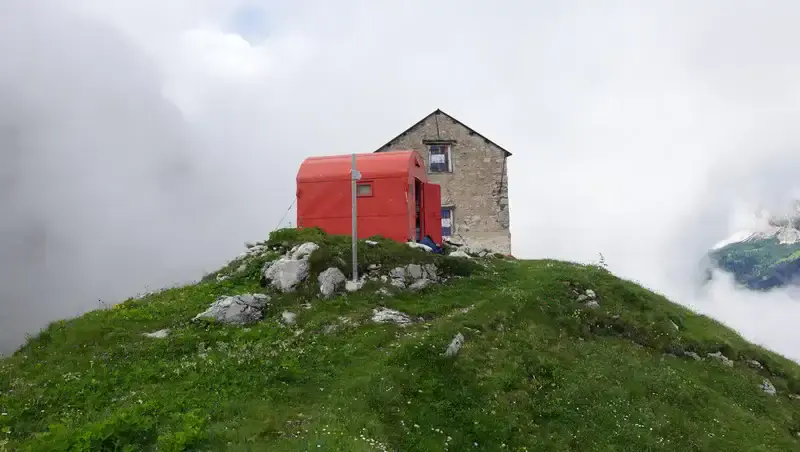
Former caseras and military barracks
In Italian, the word “casera” refers to a mountain hut, dairy farm, or alpine shelter, typically found in the Alps or other mountainous regions. These buildings were traditionally used for cheese-making and livestock farming, especially for aging and storing cheese like Casera cheese from the Valtellina region.
Today, some casere (plural of casera) are still active dairy farms, while others have been converted into refuges or mountain lodges for hikers and tourists. They are often located in high-altitude pastures where cows or sheep graze during the summer months.
As for military barracks, these are buildings that were used by military before the WWI and during the war. This area was a border land between Italy and Austro-Hungarian empire, and this was also a front line during the WWI, hence their origin.
The most spectacular example is the Bivacco Buffa di Perrero, see the picture below. You will find it easily in the map below, it is located in the north-east from Cortina d’Ampezzo. This shelter is at 2700 meters of elevation on Monte Cristallo.
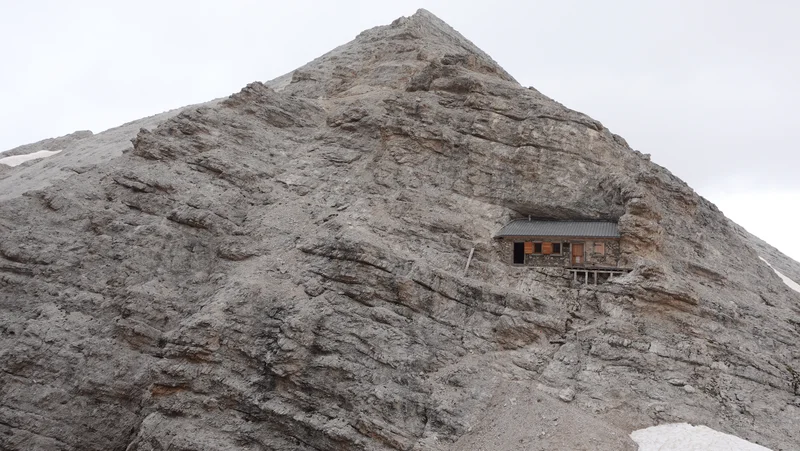
123 Dolomites shelters and bivouacs interactive map
The picture of the map is given below, so please note the following:
- These are not official mountain huts. All the shelters here are without a permanent custodian, so there is no food available.
- When you hover above a marker, it gives you the name of the shelter, and its coordinates.
- All markers in the map are clickable. When you click you will have possibility to see more information about the shelter. This includes the Google map, in most cases with photos, statements by visitors, and lots of other stuff.
- When you zoom into the map, you will see more details regarding the terrain, access roads and routes, the names of surrounding peaks, etc.
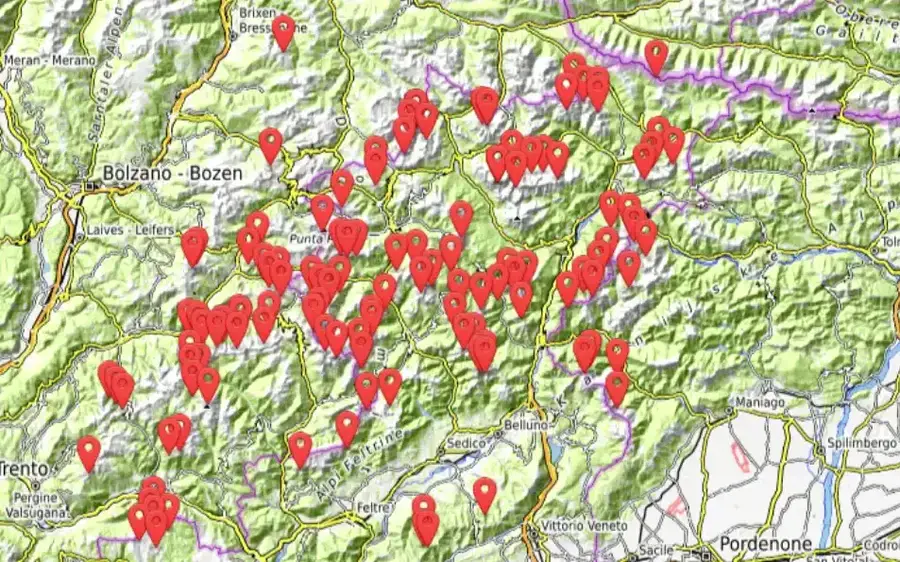
Note that these shelters are maintained by various individuals and groups, and it is far from easy to do this. In one particular example, I was reading about a person who goes there several times in a season to clean and to carry eventual garbage to the valley in his own backpack.
So make sure that you do not leave thrush around, and keep the place as clean as possible.
Now, if you are getting excited about visiting some of the bivouacs, I would warmly suggest that you read about what to expect in such shelters, to avoid unpleasant surprises and to be ready.
How about regular huts?
As you can imagine, the Dolomites are very popular and urbanized. There are many small mountain hotels, guest houses, and huts, and it is difficult to know which is which.
So there are many places that offer accommodation, but they are not true mountain huts. This holds in particular for the so-called ‘malga’ buildings, you will find them even at very high elevations.
In any case, the map below shows most of the official mountain huts in the Dolomites. They are given with blue markers and you can see how they are distributed regarding the previously discussed bivouacs (red markers).

Clearly, the huts are abundant in the most popular areas. Some of them are on roads and accessible by a car, and some are close to lift stations.
Unlock the Full Premium Interactive Map
The overview and instructions above are free for everyone. For the complete experience, get instant lifetime access to the full interactive map with all locations.
- All curated bivacchi, casere, and shelters with precise markers
- Clickable pins linking to detailed hike articles on this site or to Google
- Fully zoomable, searchable, and mobile-friendly
- Regular updates as new locations are verified
- One-time payment – no subscriptions
- Bonus: extra map with regular huts and bivouacs together!
Instant access after payment • Supports independent Dolomites hiking content
Note again that all the markers in the maps are clickable so you have links for all of them with additional information.
You will want to check also my separate map with 3000ers peaks in the Dolomites, this will be useful together with the map of shelters that you have here.
Thank you for reading. Do let me know if you would wish to know more about the Dolomites. I have been there a number of times and know the area well, see my page here in the site about the Italian Alps.
Check also my map with huts and bivouacs in the Adamello-Presanella group. Please join us at our Facebook group Dolomites Visitors Hub.
But let me know also if you have something to add and to comment, there is a comment box below.
Leave a Reply